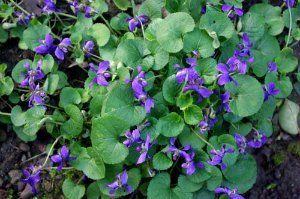Description: Sweet Violet, scientifically known as Viola odorata, is a delightful perennial herbaceous plant belonging to the Violaceae family. Commonly referred to as Horse Hoof, this charming species is celebrated for its fragrant flowers and heart-shaped leaves. Native to Europe and Asia, Sweet Violet has become a beloved addition to gardens, valued for both its aesthetic appeal and aromatic qualities.
Habitat and Distribution: Sweet Violet thrives in a variety of habitats, including woodlands, meadows, and cultivated gardens. Its adaptability to partial shade and preference for well-drained soils make it a versatile plant. While native to Europe and Asia, Sweet Violet has been introduced and naturalized in various regions worldwide.
Physical Features:
- Leaves: Sweet Violet produces a basal rosette of heart-shaped leaves with distinct veining and serrated edges. The leaves contribute to the plant's lush appearance.
- Flowers: The fragrant flowers of Sweet Violet are a highlight, with five petals forming a characteristic face and a distinctive spur at the back. Flower colors range from shades of purple to white and pink.
Ecological Significance:
Sweet Violet plays ecological roles, including:
- Pollinator Attraction: The fragrant blooms attract pollinators such as bees and butterflies, promoting pollination and supporting local biodiversity.
- Ground Cover: With its low-growing habit, Sweet Violet contributes to ground cover, helping stabilize soils and prevent erosion.
Cultural Uses:
- Ornamental Value: Sweet Violet is a popular ornamental plant, often used in gardens, borders, and containers for its aesthetic appeal.
- Fragrance: The flowers are prized for their sweet fragrance, making Sweet Violet a favorite for scented gardens.
- Culinary Uses: In some culinary traditions, Sweet Violet flowers are used for garnishing salads or making infused syrups.
Concerns and Challenges:
- Invasiveness: While generally well-behaved in gardens, Sweet Violet has the potential to spread rapidly, which may lead to concerns about invasiveness in certain settings.
Control and Management:
Cultural Practices:
- Regular Monitoring: Regularly monitor Sweet Violet in garden settings to detect any signs of aggressive spreading. Early intervention is key to managing its growth.
- Strategic Placement: Consider planting Sweet Violet in areas where its spread can be easily managed or using barriers to control its growth.
Mechanical Control:
- Hand Pulling: For small infestations, hand pulling is an effective method. Ensure the removal of the entire plant, including the root system.
Mulching:
- Mulch Application: Applying mulch around Sweet Violet can help suppress its growth, inhibit seed germination, and maintain a more controlled appearance.
Chemical Control (if necessary):
- Selective Herbicides: In cases where manual control is challenging, selective herbicides designed for broadleaf weed control can be considered. Careful application is crucial to avoid harm to desirable plants.
Preventing Spread:
- Regular Inspection: Regularly inspect planted areas to identify and address any signs of uncontrolled spreading by Sweet Violet.
- Containment Strategies: Utilize physical barriers or containers to contain Sweet Violet, preventing it from encroaching into unwanted areas.
- Proactive Management: Proactively manage Sweet Violet in garden settings by periodically thinning or dividing plants, preventing overcrowding and maintaining a more controlled growth pattern.
In conclusion, Sweet Violet brings beauty and fragrance to gardens, but its potential for rapid spreading requires careful management. Through vigilant monitoring, strategic planting, and appropriate control measures, gardeners can enjoy the delightful qualities of Sweet Violet while maintaining a harmonious and controlled garden environment.



